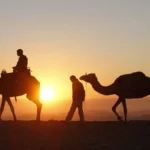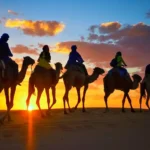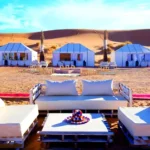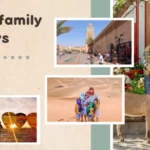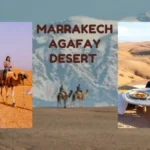Table of Contents
Standing before the magnificent Casablanca Hassan II Mosque for the first time is like witnessing a prayer carved in stone and light, a moment where the Atlantic Ocean meets architectural poetry, and time seems to pause in reverence. This stunning mosque is undoubtedly Morocco’s most visited religious site. It represents the pinnacle of modern Islamic architecture, but most travel guides barely scratch the surface of what makes this place truly extraordinary.
Beyond the typical tourist facts lies a deeper story of ambition, faith, and architectural mastery that took 13 years to complete. Whether you’re planning your first Hassan II Mosque visit or seeking insider knowledge to enhance your experience, this comprehensive guide delivers everything you need to know, from practical logistics to hidden architectural details that even seasoned travelers often miss.
Quick Facts & Logistics
| Feature | Details |
|---|---|
| Opening Hours | Sat-Thu, tours at 9am, 10am, 11am, 12pm, 3pm, 4pm |
| Ticket Price | 130 MAD (Adults), 65 MAD (Students), 30 MAD (Children) |
| Ticket Office | Located at the west entrance, inside the museum building |
| Must-Have | Scarf/shawl for women, modest clothing for all |
| Tour Duration | 45-60 minutes |
| Languages | Arabic, French, English, Spanish, German |
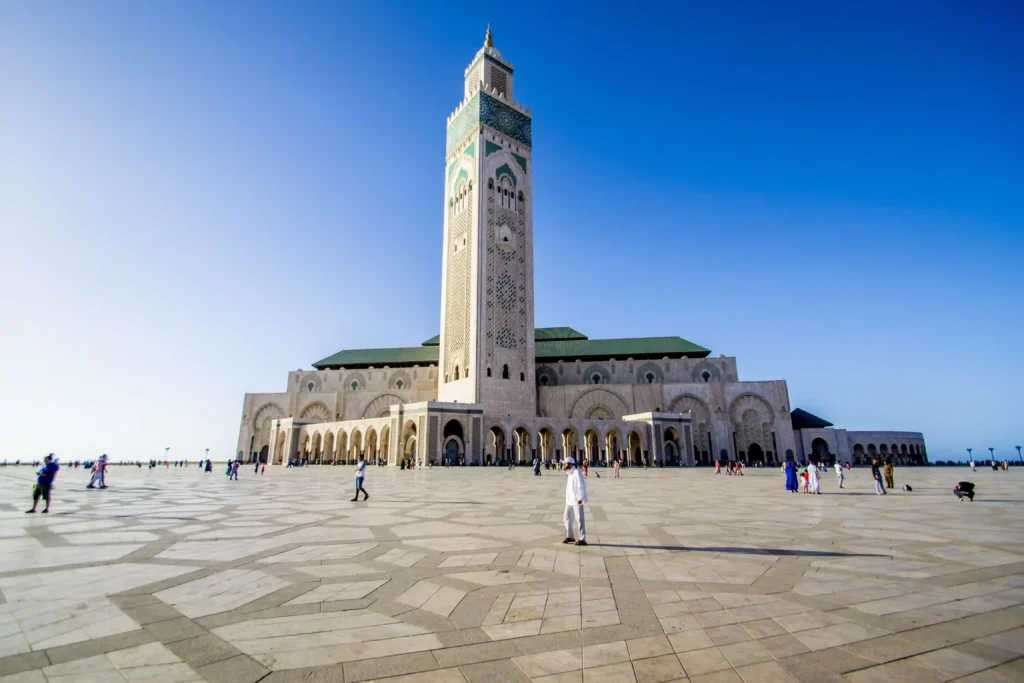
More Than a Building: Why the Hassan II Mosque is a Must-See
The Hassan II Mosque isn’t just Morocco’s largest mosque; it’s a testament to what happens when a nation dreams together. When King Hassan II announced this ambitious project in 1980, he didn’t just commission a building; he invited every Moroccan to participate in creating something that would honor both their faith and their country’s place in the modern world.
What followed was an extraordinary 13-year journey that saw donations pour in from taxi drivers, farmers, and business owners alike. Children brought their piggy bank savings, and families contributed whatever they could spare. This wasn’t just royal patronage; it was a grassroots movement that raised over $800 million through voluntary contributions, making every Moroccan a stakeholder in this architectural marvel.
The mosque’s location tells its own story. Perched on a promontory overlooking the Atlantic Ocean, it fulfills the Quranic verse “His throne was upon the water,” while its position allows the faithful to pray facing Mecca across the sea. This symbolic placement bridges Morocco’s Islamic heritage with its Atlantic identity, representing the country’s role as a gateway between Africa, Europe, and the Middle East.
But what truly sets the Casablanca Hassan II Mosque apart is its bold embrace of modernity within traditional Islamic architecture. The retractable roof, laser-guided minaret beam, and heated floors represent Morocco’s vision of Islam in the 21st century, deeply rooted in tradition yet unafraid of innovation. This philosophical approach makes it far more than a tourist destination; it’s a living symbol of how faith and progress can coexist.
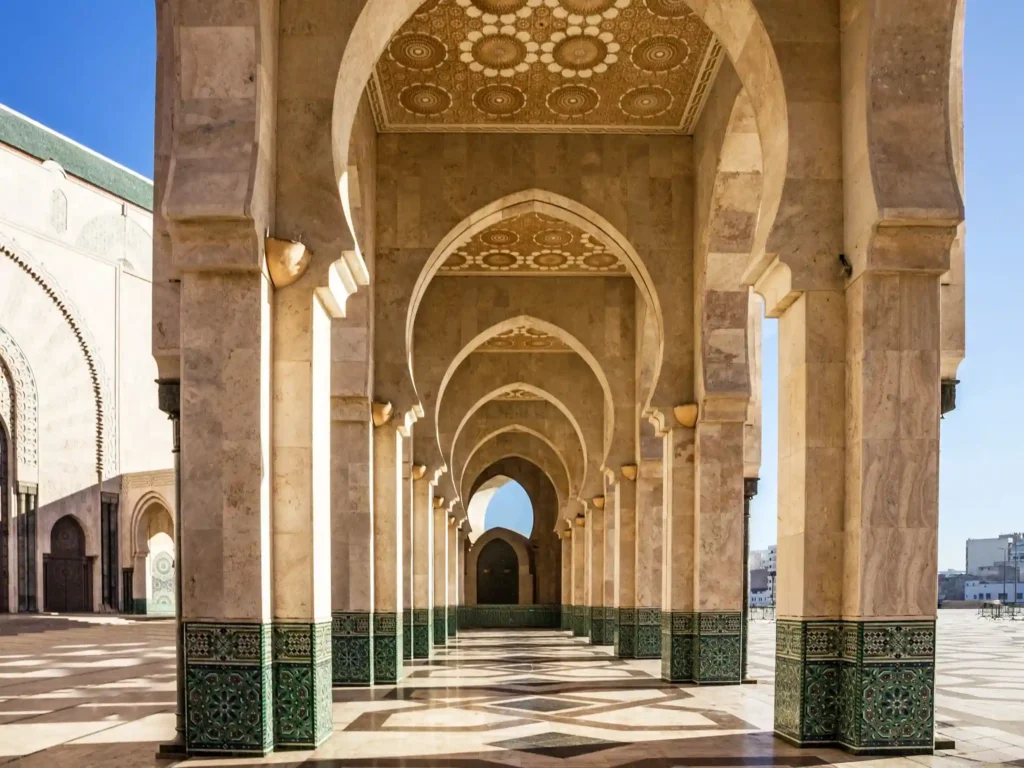
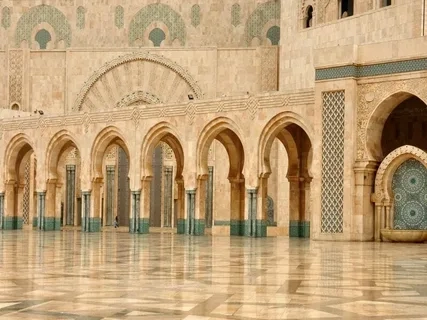

The Complete Guide to Your Hassan II Mosque Tour
Getting There: Maps, Taxis, and Walking Routes
Reaching the Hassan II Mosque is straightforward, but knowing your options can save both time and money. The mosque sits in the Aïn Diab area, approximately 7 kilometers from central Casablanca.
By Taxi: The most convenient option for most travelers. A petit taxi from the city center should cost 20-30 MAD (negotiate the price beforehand or ensure the meter is running). Ask for “Mosquée Hassan II,” or “Corniche Aïn Diab.” The journey takes 15-20 minutes, depending on traffic.
With Desert Merzouga Tours: For a seamless experience, our customized Casablanca day tours include comfortable transportation directly to the mosque with professional guides who enhance your visit with cultural insights and historical context. This eliminates the stress of navigation and ensures you maximize your time at this incredible site.
By Tram: Take Tram Line 1 to the Casablanca Hassan II Mosque stop, the most budget-friendly option at just 6 MAD. The tram runs every 10-15 minutes and offers a scenic route through the city. From the tram stop, it’s a pleasant 5-minute walk to the mosque entrance.
By Walking: If you’re staying in the nearby Aïn Diab district, the mosque is easily accessible on foot. The walk along the Corniche offers beautiful ocean views and takes about 20-30 minutes from most hotels in the area.
Insider Tip: Arrive 30 minutes before your tour time to account for ticket purchasing and security checks. The area can get crowded, especially during peak tourist seasons.
The Ticket-Buying Process, Demystified
Many first-time visitors feel uncertain about the ticket-buying process, but it’s quite straightforward once you know where to go. The ticket office is located at the west entrance of the mosque complex, inside a dedicated museum building, not at the main mosque entrance where many tourists initially head.
Step-by-Step Process:
- Locate the Museum Building: Look for the modern, glass-fronted building to the west of the main mosque. Signs in multiple languages will guide you to “Billets” or “Tickets.”
- Payment Options: The ticket office accepts both cash (Moroccan Dirhams) and major credit cards. However, having cash on hand is recommended as card machines occasionally experience technical issues.
- Group Discounts: If you’re traveling with a group of 10 or more, ask about group rates; they’re often available but not always advertised. Desert Merzouga Tours agency can arrange group bookings and secure the best available rates while handling all logistics for larger parties.
- Language Selection: When purchasing tickets, you’ll be asked to choose your preferred tour language. English and French tours are most frequent, but Spanish and German options are available for certain time slots.
What You’ll Receive: Your ticket includes a small map of the mosque complex and a brief information sheet in your chosen language. Keep this handy during your visit; it contains useful details about what you’ll see.
Hassan II Mosque Opening Hours & Tour Times 2025
Understanding the Casablanca mosque opening hours is crucial for planning your visit. The mosque operates on a structured schedule that varies slightly throughout the year.
Regular Schedule (October – March):
- Morning Tours: 9:00 AM, 10:00 AM, 11:00 AM, 12:00 PM
- Afternoon Tours: 2:00 PM, 3:00 PM, 4:00 PM
Summer Schedule (April – September):
- Morning Tours: 9:00 AM, 10:00 AM, 11:00 AM, 12:00 PM
- Afternoon Tours: 3:00 PM, 4:00 PM, 5:00 PM
Important Notes:
- Friday Closure: The mosque is closed to tourists on Fridays for the weekly Jumu’ah prayer
- Ramadan Schedule: During Ramadan, tour times are adjusted, with limited afternoon slots. Check the official website or call ahead during this period
- Religious Holidays: The mosque may close for major Islamic holidays like Eid al-Fitr and Eid al-Adha
Booking Strategy: While advance booking isn’t always necessary, it’s highly recommended during peak season (June-August) and major holidays. The 10:00 AM and 2:00 PM tours tend to be most popular.
Expert Tip from Desert Merzouga Tours: Our Morocco specialists recommend combining your Hassan II Mosque visit with other Casablanca highlights like the Royal Palace and Hassan II Square. We can arrange perfectly timed itineraries that account for tour schedules and optimal lighting conditions for photography.
Hassan II Mosque dress code: What to Wear (with Examples)
The dress code for the Hassan II Mosque visit is strictly enforced, and inappropriate attire will result in denied entry no exceptions. However, dressing appropriately doesn’t mean sacrificing comfort or style.
For Women:
- Tops: Long-sleeved shirts, blouses, or tunics that cover the arms completely. A lightweight linen shirt or flowy tunic works perfectly
- Bottoms: Full-length pants or maxi skirts that reach the ankles. Avoid anything that shows the shape of your legs too clearly
- Head Covering: A scarf or shawl to cover your hair is mandatory. Pack a lightweight scarf, even if you don’t typically wear one
- Footwear: Comfortable slip-on shoes are ideal since you’ll need to remove them multiple times
For Men:
- Tops: Collared shirts or polo shirts with sleeves. Tank tops and sleeveless shirts are not permitted
- Bottoms: Long pants, no shorts, regardless of length. Chinos or lightweight trousers are perfect for Morocco’s climate
- Footwear: Easy-to-remove shoes are recommended
Universal Guidelines:
- Colors: While any color is acceptable, avoid overly bright or flashy clothing
- Fit: Clothing should be loose-fitting rather than tight or form-fitting
- Fabrics: Breathable fabrics like cotton and linen are ideal for Morocco’s climate
What to Avoid:
- Mini skirts, shorts, or capri pants
- Low-cut tops or anything showing cleavage
- Transparent or see-through clothing
- Clothing with offensive slogans or imagery
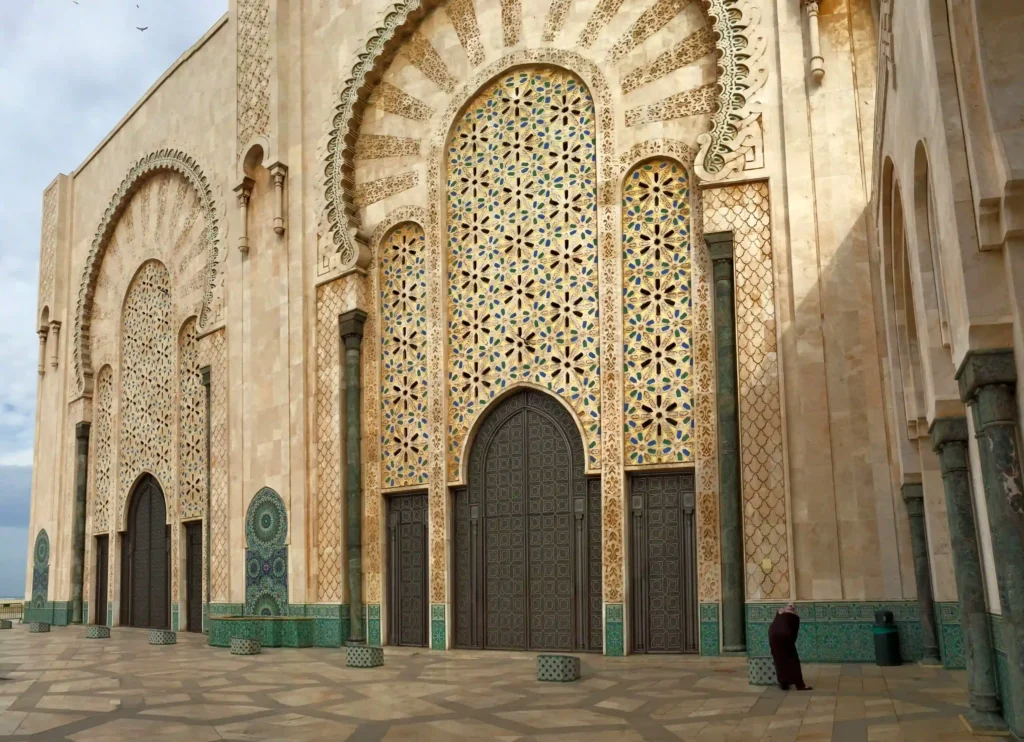
What to Expect on the Guided Tour
Your Hassan II Mosque tour begins at the museum building where you’ll meet your certified guide. All guides are officially licensed and speak multiple languages fluently. These aren’t just tour guides; they’re cultural ambassadors who can answer questions about Islamic architecture, Moroccan history, and religious practices.
The Tour Route: The guided tour follows a carefully planned route that maximizes your experience while respecting the mosque’s sacred nature. You’ll start with an introduction to the mosque’s history and significance before entering the main complex.
Shoe Removal Protocol: Before entering the prayer hall, you’ll remove your shoes and place them in designated areas with numbered tags. Don’t worry, the system is well-organized, and you’ll retrieve them easily at the end of the tour.
Key Areas You’ll Visit:
- The Prayer Hall: The heart of the mosque, capable of accommodating 25,000 worshippers. Your guide will explain the significance of the mihrab (prayer niche) and minbar (pulpit), while highlighting the intricate geometric patterns and calligraphy.
- The Ablution Hall: Located in the basement, this area features marble fountains and demonstrates the ritual washing process that precedes prayer. The architecture here is equally impressive, with natural light filtering through glass floors.
- The Mezzanine Level: Offers spectacular views of the main prayer hall and showcases the mosque’s incredible scale and craftsmanship.
Interactive Elements: Modern touches include demonstrations of the retractable roof mechanism and explanations of the mosque’s earthquake-resistant design. Many visitors are surprised to learn about the building’s high-tech features, including heated floors and a state-of-the-art sound system.
Photography Opportunities: Unlike many religious sites, photography is not only allowed but encouraged throughout the tour. Your guide will point out the best angles and lighting conditions for capturing memorable photos.
The “AI Moat” – An Insider’s Look at the Mosque
The Photographer’s Shot List: 5 Photos You Must Capture
Professional photographers and Instagram influencers alike consider the Hassan II Mosque one of the world’s most photogenic religious buildings. Here are the five essential shots that will make your friends want to book their own Morocco tour:
1. The Minaret Reflection at Golden Hour Position yourself on the ocean-facing side of the mosque about 30 minutes before sunset. The 210-meter minaret—the world’s tallest- creates a stunning reflection in the wet sand and tidal pools. Use a wide-angle lens to capture both the minaret and its reflection, creating a symmetrical composition that’s pure Instagram gold.
2. The Geometric Ceiling Patterns Inside the prayer hall, look up to capture the intricate geometric patterns carved into the cedar ceiling. Use your phone’s portrait mode or a camera with good low-light capability. The natural light filtering through the retractable roof creates beautiful shadows that highlight the three-dimensional nature of the carving.
3. The Prayer Hall’s Marble Columns The massive marble columns supporting the prayer hall create natural leading lines. Stand at the back of the hall and use a wide-angle lens to capture the perspective, showing how the columns draw the eye toward the ornate mihrab. This shot emphasizes the mosque’s incredible scale.
4. The Ablution Hall’s Underwater Effect The glass floors in the ablution hall create an ethereal underwater effect with light dancing through the water below. Capture this from above, showing the geometric patterns of the fountains reflected in the glass. It’s a unique architectural feature you won’t find anywhere else.
5. The Atlantic Ocean Backdrop: From the mosque’s ocean-facing courtyard, capture the building’s silhouette against the Atlantic Ocean. Early morning light creates a serene, meditative atmosphere, while late afternoon provides a dramatic contrast. This shot perfectly captures the mosque’s unique coastal location.
The Story Behind the Stone: 3 Architectural Details You Can’t Miss
The Retractable Roof: Engineering Meets Faith The Hassan II Mosque’s retractable roof isn’t just a technical marvel; it’s a spiritual statement. Designed to open in just three minutes, this 3,400-square-meter masterpiece allows natural light to flood the prayer hall, creating an outdoor worship experience while maintaining the intimacy of an enclosed space. The engineering required to support this massive moving structure while preserving the building’s acoustic properties represents a fusion of traditional Islamic architecture with cutting-edge technology.
The roof’s design incorporates traditional Moroccan geometric patterns, but uses modern materials like titanium and steel. When closed, it creates perfect acoustics for prayer and speech. When open, it transforms the space into something unprecedented in Islamic architecture, a mosque that opens to the heavens.
The Titanium Doors: Guardians of Sacred Space. The mosque’s main entrance features massive doors crafted from titanium, chosen not just for durability but for its symbolic significance. Titanium doesn’t tarnish or corrode, representing the eternal nature of faith. Each door weighs over 35 tons and features intricate geometric patterns that tell the story of Morocco’s Islamic heritage.
These aren’t just functional elements; they’re artistic statements that required master craftsmen to work with space-age materials using traditional techniques. The doors open electronically but can also be operated manually, ensuring the mosque remains accessible even during power outages, a practical consideration that speaks to the builders’ attention to detail.
The Hand-Carved Cedar Ceilings: A Disappearing Art. The mosque’s cedar ceilings represent the pinnacle of traditional Moroccan craftsmanship, featuring hand-carved geometric patterns that took master artisans over five years to complete. These intricate designs, known as “taqsim,” follow mathematical principles that create infinite patterns without repetition, a visual representation of the infinite nature of Allah.
What makes these ceilings extraordinary is the dying art of traditional wood carving. The craftsmen who created these patterns learned their skills through generations of family tradition, using techniques that haven’t changed in centuries. Each section required months of careful carving, with no room for error in the complex geometric relationships.
The cedar itself comes from Morocco’s Middle Atlas Mountains, chosen for its aromatic properties and resistance to insects. As you stand beneath these ceilings, you’re experiencing not just architectural beauty but the culmination of centuries of Moroccan artistic tradition.
Beyond the Hassan II Mosque: What to Do Nearby
Your Hassan II Mosque experience doesn’t have to end when the tour concludes. The surrounding area offers perfect opportunities to extend your cultural journey and reflect on what you’ve experienced.
Complete Your Cultural Journey with Desert Merzouga Tours. While the Hassan II Mosque is undoubtedly Casablanca’s crown jewel, it’s just one element of Morocco’s rich cultural tapestry. Desert Merzouga Tours specializes in creating comprehensive Morocco experiences that weave together architectural marvels like the Hassan II Mosque with the imperial cities of Fes and Marrakech, the dramatic landscapes of the Atlas Mountains, and the mystical beauty of the Sahara Desert.
Café Maure: Post-Tour Mint Tea Perfection Just a 10-minute walk from the mosque along the Corniche, Café Maure offers the perfect setting for post-tour reflection. This traditional Moroccan café serves authentic mint tea and light pastries with stunning ocean views. The café’s white-washed walls and blue accents create a quintessentially Moroccan atmosphere that complements your mosque visit perfectly.
Order the traditional mint tea service; it’s not just a drink but a cultural experience. The tea is poured from a height to create the perfect foam, and the three glasses you’ll be served represent different aspects of life: the first glass is bitter like death, the second sweet like love, and the third gentle like life itself.
Corniche Aïn Diab: Morocco’s Miami Beach. The Corniche stretches for kilometers along Casablanca’s coastline, offering a perfect way to decompress after your spiritual journey. This oceanside promenade features palm trees, beach clubs, and stunning Atlantic views. It’s particularly magical at sunset when the sky transforms into a canvas of oranges and purples.
The contrast between the sacred space of the mosque and the leisurely atmosphere of the Corniche perfectly represents modern Morocco—a country that seamlessly blends tradition and contemporary life. Pack comfortable walking shoes and allow at least an hour to fully appreciate this beautiful stretch of coastline.
Rick’s Café: Hollywood Comes to Casablanca. For movie buffs, Rick’s Café recreates the famous establishment from the 1942 film “Casablanca.” While Humphrey Bogart and Ingrid Bergman never actually set foot in Morocco, this faithful reproduction captures the romantic atmosphere of the movie while offering excellent Moroccan and international cuisine.
The café features live piano music, classic cocktails, and memorabilia from the film. It’s a fun way to end your day, especially if you’re traveling with someone who appreciates classic Hollywood cinema. The contrast between the ancient traditions of the mosque and the mid-20th-century glamour of Rick’s Café showcases the many layers of Moroccan culture.
Morocco Mall: Modern Shopping Experience If you’re interested in contemporary Moroccan lifestyle, Morocco Mall offers a glimpse into modern Casablanca. This massive shopping center features international brands, local artisans, and a spectacular aquarium. It’s particularly interesting for travelers who want to see how young Moroccans live and shop.
The mall’s architecture incorporates traditional Moroccan design elements with modern retail concepts, creating a unique shopping environment. It’s also a great place to purchase high-quality Moroccan products like argan oil, spices, and textiles from reputable sellers.
Frequently Asked Questions
How long does the Hassan II Mosque tour last? The guided tour typically lasts 45-60 minutes, depending on group size and the number of questions asked. However, plan for about 90 minutes total when you include time for ticket purchasing, security checks, and walking through the complex. The tour moves at a comfortable pace, allowing time for photos and questions.
Can you visit the Hassan II Mosque without a tour? No, non-Muslims can only enter the mosque as part of an official guided tour. This policy ensures respectful visits while maintaining the mosque’s sacred nature. Independent exploration of the exterior courtyards and gardens is permitted, but access to the prayer hall and other interior spaces requires tour participation.
Is the Hassan II Mosque worth visiting? Absolutely. The mosque represents one of the finest examples of contemporary Islamic architecture in the world. Beyond its architectural significance, it offers insight into modern Morocco’s cultural identity and spiritual life. Many visitors describe it as a transformative experience that deepens their understanding of Islamic culture and Moroccan craftsmanship.
The investment in time and money pays dividends in cultural understanding and photographic opportunities. Even travelers who typically avoid religious sites find the Hassan II Mosque compelling due to its architectural innovation and cultural significance.
Can you take photos inside the Hassan II Mosque? Yes, photography is not only allowed but encouraged throughout the tour. However, be respectful of other visitors and follow your guide’s instructions about flash photography in certain areas. The mosque’s architects designed it to be photographed, with excellent natural lighting that makes even smartphone photos look professional.
Video recording is also permitted, making it possible to capture the acoustic properties of the prayer hall and the mechanical operation of the retractable roof. Many visitors create stunning time-lapse videos of their tour experience.
How can I combine the Hassan II Mosque with other Morocco experiences? Desert Merzouga Tours excels at creating seamless itineraries that connect Casablanca’s highlights with Morocco’s other treasures. Popular combinations include the Hassan II Mosque with the blue city of Chefchaouen, the historic kasbahs of Aït Benhaddou, and authentic Sahara Desert experiences. Our custom tours ensure each destination enhances the others, creating a cohesive cultural journey rather than disconnected sightseeing stops.
What makes Desert Merzouga Tours different for Hassan II Mosque visits? Our local expertise ensures you experience the mosque within its cultural context. We provide professional guides who understand both Islamic architecture and Moroccan history, premium transportation that eliminates navigation stress, and authentic cultural experiences like traditional hammams and cooking classes that complement your spiritual journey. Every detail is handled professionally, allowing you to focus on the transformative experience of visiting this architectural masterpiece.
What is the best time to visit the Hassan II Mosque? The best time depends on your priorities. Morning tours (9:00-11:00 AM) offer the best lighting for interior photography and are less crowded. Afternoon tours provide beautiful exterior shots with the ocean backdrop. Avoid the noon tour if possible, as it coincides with the heat of the day.
For the most comfortable experience, visit between October and April when temperatures are moderate. Summer visits are still enjoyable, but arrive early to avoid the afternoon heat.
Are there any restrictions for children? Children are welcome on tours, but parents should ensure they can maintain respectful behavior throughout the 45-60 minute experience. The mosque provides an excellent educational opportunity for children to learn about different cultures and architectural styles.
Children under 12 receive discounted tickets, and babies in strollers are accommodated. However, the tour involves considerable walking and standing, so consider your child’s attention span and physical capabilities.

Conclusion of Casablanca Hassan II Mosque
The Hassan II Mosque stands as more than just Casablanca’s most famous attraction, it’s a living testament to Morocco’s ability to honor its spiritual heritage while embracing the future. From its engineering marvels like the retractable roof to its deeply traditional hand-carved cedar ceilings, every element tells a story of a nation that refuses to choose between authenticity and innovation.
Whether you’re drawn by the architectural splendor, the cultural significance, or simply the opportunity to experience something truly unique, a Hassan II Mosque visit delivers rewards that extend far beyond typical sightseeing. The mosque challenges assumptions about Islamic architecture, demonstrates the power of collective national effort, and provides a peaceful space for reflection in our increasingly busy world.
As you plan your Morocco adventure, remember that the Hassan II Mosque isn’t just a stop on your itinerary; it’s a window into the soul of modern Morocco. The hour you spend within its walls will enhance your understanding of everything else you experience in this fascinating country.
Ready to Experience Morocco’s Architectural Masterpiece? Desert Merzouga Tours transforms your Hassan II Mosque visit into part of an unforgettable Morocco journey. Our expert guides, premium transportation, and authentic accommodations ensure every moment of your trip reflects the same attention to detail and cultural respect that makes the mosque so special. Whether you’re planning a comprehensive Morocco tour or a focused Casablanca experience, we create personalized itineraries that honor both your interests and Morocco’s rich heritage.
Contact Desert Merzouga Tours today to begin planning your Morocco adventure, and don’t forget to download our Free Hassan II Mosque Pre-Visit Checklist to have all the essential information right on your phone, including offline maps, phrase translations, and packing reminders that will ensure your visit goes smoothly from start to finish!

